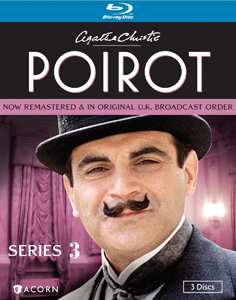“Agatha Christie’s Poirot” became a well-oiled machine in Season 2, and it classes things up further in Season 3 (1990-91, ITV). While retaining its vibe as a “comfort show,” it also gets stylish, with composer Christopher Gunning providing specific vibes to suit each episode’s setting, theme and events.
For the first time – following the slight misfire of Season 2’s “Peril at End House” – “Poirot” hits a home run with a novel adaptation. Smartly, “Poirot” goes back in time to position “The Mysterious Affair at Styles” as the first-chronicled adventure of these characters played by David Suchet, et. al., just as it is for their literary equivalents.
Although “Poirot” goes deeper into the grab bag of short stories to adapt, it didn’t necessarily adapt them in order of best to worst, so there are still a lot of good ones. A ding against Season 3 is that Christie’s plots – as adapted by several writers, with Clive Exton overseeing them – aren’t as consistent. But on the other hand, the emotions and themes expand, accidentally hinting at “Poirot’s” serious tone of several seasons later.

“Agatha Christie’s Poirot” Season 3 (1990-91)
ITV, 11 episodes
Writers: Clive Exton, Andrew Marshall, Anthony Horowitz, Rod Beacham, David Renwick, T.R. Bowen
Starring: David Suchet, Hugh Fraser, Pauline Moran
Here are my rankings of the 11 episodes of “Poirot” Season 3, along with the U.S. collection the source material can be found in:
1. “The Mysterious Affair at Styles” (episode 1, written by Clive Exton; double-length)
This adaptation of Christie’s 1920 debut novel serves as a pilot-after-the-fact. You could watch it first, if doing a “Poirot” rewatch. It benefits from everything the cast and crew have learned so far, but goes the extra mile to enrich the characters. Set in wartime 1917, “Styles” shows us Poirot (Suchet) as a Belgian refugee trying to keep his spirits up, Hastings (Hugh Frasier) as war-numbed, and Japp (Philip Jackson, with a mustache dyed darker) as someone who may not be as wise as Poirot, but he’s wise enough to see Poirot can help him. The production is wonderful, with candle-lit rooms in the mansion, and many scenes playing out precisely as I envisioned them from the novel.
Novel: “The Mysterious Affair at Styles”
2. “The Plymouth Express” (4, Rod Beacham)
This is a landmark episode, as writer Beacham – despite making his only contribution to the series – and director Andrew Piddington ratchet up the emotions. We feel the tragedy of the victim’s death, both from the pain of her father, who asks for Poirot’s help, and from the way her murder is staged in a classy horror-movie fashion. The episode’s existence itself is bizarrely fascinating, because Christie turned this 1923 short story into 1928’s “The Mystery of the Blue Train,” but that novel will also be adapted, in Season 10.

Story: “The Under Dog and Other Stories”
3. “The Mystery of the Spanish Chest” (8, Anthony Horowitz)
This adaptation of a story that debuted as “The Mystery of the Baghdad Chest” (1932) is evocative because it calls to mind Alfred Hitchcock’s “Rope” (1957), adapted from a 1929 play. Dare I say that this episode is more striking and satisfying than “Rope”? Part of it is because of the scheming that goes into luring the victim into the chest, and then the grisly nature of the murder. The fencing scenes, with the baddie attempting to stab Poirot to death, edges toward silliness, although it’s definitely something different.
Stories: “The Regatta Mystery and Other Stories” (“Baghdad Chest”) and “The Harlequin Tea Set” (“Spanish Chest”)
4. “Wasps’ Nest” (5, David Renwick)
It’s always fascinating when Poirot goes extra-judicial, and this adaptation of a 1928 yarn is helped by a love triangle where things are not what they appear. Luckily, of course, Poirot can see beneath the surface to the truth. Starting with a colorful fete and ending with much darker themes, this is an emotional roller-coaster, but in a good way.
Story: “Double Sin and Other Stories”
5. “The Tragedy at Marsdon Manner” (6, Renwick)
Even though the supernatural doesn’t exist in the Christie-verse (except, arguably, in the Mr. Quinn stories), I’m a sucker for her tales that hint at the spiritual realm. This adaptation of a 1923 “ghost” yarn is helped by forbidding woods at the edge of the titular estate. In Season 3, the writers have fun explaining Poirot’s presence in stories where Christie had just plopped him there. Entertainingly, a jolly hotelier lures an annoyed Poirot to the area to help him with his manuscript.
Story: “Poirot Investigates”
6. “The Mystery of Hunter’s Lodge” (11, T.R. Bowen)
The mood of this adaptation of a 1924 piece is among the season’s strongest, with nighttime scenes enhanced by Gunning’s grim score. If you’ve watched the season in a few sittings, the schemes of previous villains might help you solve the finale’s mystery, just as Poirot does from his sickbed (with Hastings feeding him information). Disguises are always more of a challenge on screen than on the page, but this episode pulls off the trick well, via false teeth.
Story: “Poirot Investigates”
7. “How Does Your Garden Grow?” (2, Andrew Marshall)
In this adaptation of a 1935 tale, we’re brought back to a time when non-Communist Russians were expelled from their country. In some circles they have to pretend to be Communists, and in others they can openly be in favor of Western values. Poirot, having likewise been displaced from his homeland, has sympathy for a couple such Russians. The love story’s and mystery’s details are unlikely. But keeping the tone amusing, Poirot has a flower named after him and Hastings struggles through sneezing fits and messes up Miss Lemon’s (Pauline Moran) filing system.
Story: “The Regatta Mystery and Other Stories”
8. “The Million Dollar Bond Robbery” (3, Horowitz)
Again, with this 1923 adaptation we have something that’s more historically interesting than outstanding, as Poirot and Hastings take a huge ocean liner from the U.K. to New York. The “Forrest Gump”-style insertions of our sleuths into historical footage is well done. For some reason, I remembered the solution – and indeed, only one answer seems possible – as to how the bonds are stolen. The episode is spiced up by Hastings – having bragged about how he never gets seasick – falling ill, and another of those disguised double performances.
Story: “Poirot Investigates”
9. “The Theft of the Royal Ruby” (9, Horowitz and Exton)
The production design is top-shelf through most of Season 3, so it’s a shame that this Christmas episode – delightfully snow-covered in Christie’s 1923 tale – was shot at a time when there was no snow on the ground! The scene of a teen girl’s (supposed) corpse sprawled in the snow awkwardly shifts to a sandbox. Enough of Christie’s Christmas spirit does translate to the screen that “Royal Ruby” is worthy of your holiday rotation, but I hope for more when I get to Season 6’s “Hercule Poirot’s Christmas.”
Story: “Double Sin and Other Stories” (“Royal Ruby”) and “Midwinter Murders” (2020) (“The Adventure of the Christmas Pudding”)
10. “The Double Clue” (7, Horowitz)
Piddington’s showy directing style plays well on “Plymouth Express,” but not as well here as he heavily dramatizes the romance between Poirot and Vera Rossakoff (Kiki Markham). It’s more of a conceptual achievement than a believable one. What is it about the thieving countess that makes Poirot go extrajudicial and let her off the hook? Is it because he has the hots for her? That doesn’t seem Poirot-like. The concept of the original 1923 story bugged me, too. OK, two convenient clues left at the site of a cracked safe is one too many for Poirot. A fair theory. But how can he be so sure? I guess because the story says he can be.
Story: “Double Sin and Other Stories”
11. “The Affair at the Victory Ball” (10, Marshall)
This might’ve been fun for 1923 readers familiar with the fictional figures portrayed at the costume ball, and their metaphorical meanings. But I admit that whole layer is lost on me. And the time-shift fakery – wherein the victim is killed earlier than one would suppose – is quite apparent. The party’s lavishness can’t be quibbled with, and it’s nice to get a peek into 1930s radio production with the commercial ads performed live. But I didn’t find the story engaging, compared to other episodes.
Story: “The Under Dog and Other Stories”
IMDb Top 250 trivia
- “Poirot” ranks at No. 149 among the top 250 TV shows with an 8.6 rating.
- Rightly so, “The Mysterious Affair at Styles” ranks No. 1 on the season with a 7.9 rating. Bringing up the rear is “The Double Clue” at 7.3, so perhaps viewers aren’t as enamored with the countess as Poirot is.

